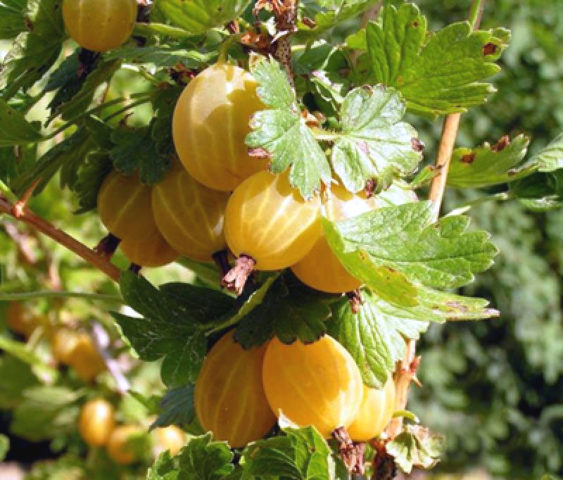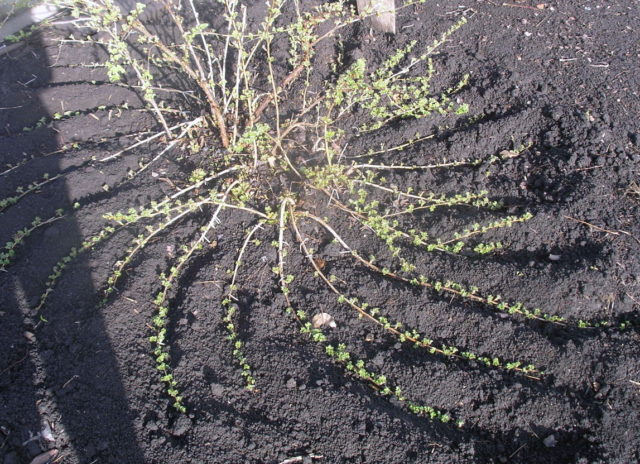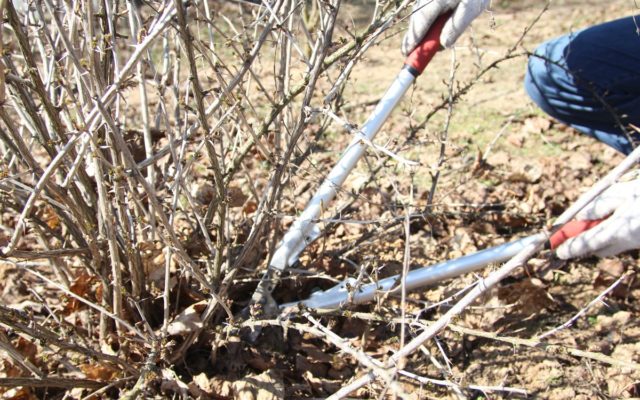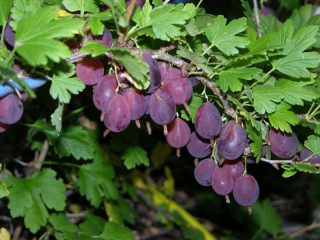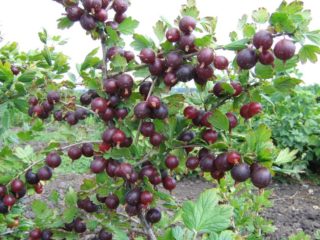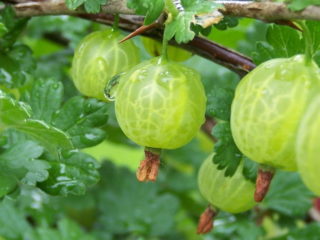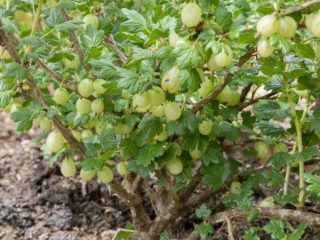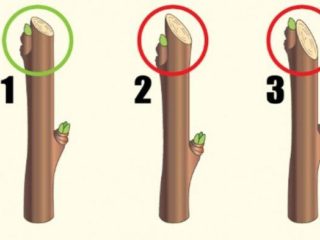Content
The gooseberry Kuršu Dzintars belongs to the Latvian selection. Obtained from crossing the varieties Stern Razhiga and Pellervo. Belongs to the mid-early yellow-fruited varieties. In 1997, included in the State Register of varieties that have been tested in the Republic of Belarus. Not included in the Russian register of selection achievements. The plant is intended for cultivation on personal plots.
Description of the gooseberry variety Kursu Dzintars
Gooseberry Kuršu Dzintars forms a compact, highly decorative bush. The spreading of the branches is average, the shoots are straight and thin. The thorns are numerous, located one at a time on the shoot, but double and triple thorns are also found. The thorns are low, very sharp, brown in color.
In the description of the variety and photo of the Kuršu Dzintars gooseberry, you can see that the berries grow one-size, medium-sized, with an average weight of 2.7 g. The shape of the berries is oval, the color is amber-yellow with pronounced veins, there is no pubescence.The skin is shiny and thin.
The leaves of the Kursu Dzintars gooseberry are medium in size, round in shape, green in color, with 3 or 5 lobes. The leaf wrinkles are weakly expressed, the color is green, matte or with a slight shine.
The gooseberry variety Kuršu Dzintars is partially self-fertile, which means that fertilization with its own pollen is about 20%.
With cross-pollination, in addition to yield, the taste and size of the berries improves.
Gooseberries with pronounced thorniness, like Kuršu Dzintars, are well adapted to cold, therefore suitable for growing in regions with different climates.
Drought resistance, frost resistance
In terms of frost resistance, the Kurši Dzintars gooseberry belongs to the 4th climatic zone. Without shelter, it can withstand temperature drops in winter down to -32OC. The gooseberry variety Kuršu Dzintars can tolerate short periods of drought.
Fruiting, productivity
The Kurši Dzintars gooseberry begins to bloom in the second ten days of May. The berry ripening period is late July - early August. It has a stable yield; an average of 4-6 kg of sweet, fragrant berries are harvested from one bush. The productivity of Kursu Dzintars is increased due to proper care.
The berries are not prone to shedding and ripen on the branch. The fruits of this variety tolerate transportation and storage well. The purpose of the berries is dessert. Kurši Dzintars gooseberries are eaten fresh and also prepared in various ways. The fruits are used to make compotes, preserves, jam and marmalade, and are used to prepare fillings for pies.
Advantages and disadvantages
The Kurši Dzintars gooseberry has a stable yield.Without reducing fruiting, the bush can grow in one place for several decades.
Other advantages of the variety:
- decorative, slightly spreading bush;
- high winter hardiness;
- the berries ripen at the same time;
- pleasant sweet taste of fruits;
- the plant is unpretentious in cultivation;
- resistant to some diseases typical for the culture.
The disadvantages or features of the variety include numerous thorns on the shoots and the small size of the berries.
Features of reproduction
Gooseberry Kurshu Dzintars takes root well after propagation by vegetative means.
Suitable propagation methods
By layering
One of the fastest and most effective methods of reproduction:
- The withdrawn shoot is pressed to the soil horizontally or in an arched manner.
- With the arcuate method, the shoot is bent only in one place in the middle. In this case, only one, but stronger shoot grows.
There is also a method of vertical layering, which is more suitable for old bushes:
- To do this, old branches are completely cut off in the fall.
- During the season, new shoots grow, during this time the bush is covered with fertile soil several times, then the rooted shoots are planted.
Cuttings
Gooseberry Kuršu Dzintars can be propagated by green, lignified or combined cuttings.
Dividing the bush
The method is suitable for propagating bushes no older than 5 years. The fruit bush is dug up completely and divided into independent parts.
Gooseberries take root well with various propagation methods due to their ability to quickly build up missing parts.
Planting and care
Kurši Dzintars gooseberry seedlings are planted both in spring and autumn. The most suitable autumn months are September-October.
A place for growing gooseberries is chosen that is sunny, taking into account the growth of bushes and their group planting. When planting a crop near a fence or walls of buildings, it is necessary to retreat at least 1 m. Gooseberries are a moisture-loving crop, but lowlands and wetlands are not suitable for cultivation. Preferred soils are fertile, with good breathability.
The planting pit is prepared on soil treated from weeds. The size of the hole should be 2 times the volume of the root system of the seedling. The soil removed from the pit is mixed with organic or mineral fertilizer.
Before planting, the roots of the seedling are freed from the earthen clod and straightened in different directions. The seedling in the planting hole is placed on a previously prepared earthen mound, covered with prepared soil, and the root collar is not buried. For watering after planting, you will need two full buckets of water, which are poured around the bush in several stages.
If there are shoots on the seedling, they are cut back to the first bud so that all the plant’s forces go to rooting. The soil around the planting is mulched with dried grass, compost or peat.
Growing rules
The Kursu Dzintars bush grows compact, but to prevent the berries from becoming small, it must be constantly thinned out. The bush should always consist of branches of different ages.
In the photo of the Kuršu Dzintars gooseberry, you can see that when pruning, part of the shoots older than 7 years is removed, as well as weakly fruiting and dry branches. Young shoots are left in the amount of 5-6 pieces. The cutting tool must be sharp and clean. The shoots are cut to the ground, leaving no stumps.
If fertilizers were applied during planting, then the following fertilizing is applied only in the 3rd year of cultivation. To do this, at the end of spring, any complex mineral fertilizers or about one bucket of well-rotted manure are applied under the bush. Fertilizer is not used at the end of summer, so as not to provoke the growth of new shoots that will not be able to ripen and survive the winter.
After planting, a young shrub is tied to a peg to set the vertical direction of growth and protect the branches from breaking in the event of strong winds.
In the fall, the bush is not tied tightly, the earth around it is mounded. For the winter, the young plant is covered with spruce branches or non-woven covering material. In winter, the bush is covered with snow, under which the Kuršu Dzintars gooseberry will withstand frosty weather well.
Pests and diseases
The Kurši Dzintars gooseberry has a high resistance to powdery mildew and an average resistance to anthracnose. Other common shrub diseases are septoria and rust. To combat diseases, solutions of copper sulfate and Bordeaux mixture are used.
Gooseberry pests:
- pale and yellow sawflies;
- moth;
- scale insect;
- shoot aphid.
In order to protect gooseberries from pests that overwinter in the soil, fallen leaves and other plant debris are carefully removed in the fall. The soil around the bush is dug up and sprayed with insecticides. In the spring, during preventive work, additional spraying of the leaves is carried out in the garden.
Conclusion
Gooseberry Kuršu Dzintars is a medium-early ripening variety, acclimatized for cold regions.Shiny amber berries look decorative on a compact bush. Kurši Dzintars gooseberries are suitable for dessert use, as well as various types of processing.
